the plate is approximately 50cm x 40cm
0.3 of carbon and 3mm of nomex honeycomb, total 3.8mm including resne etc. I haven't taken measurements and to tell the truth I'm not very interested, I will do them but I'm more interested in the response in the field, I want to know exactly how it sounds outdoors and how it sounds indoors, what is the right cross for the sub and if there are real problems not considered, at the moment everything is fine but I have to try it with real musical instruments in the various contexts, everything else like the measures I can't say I'm against it but I only trust what I hear. That said, you were talking about considering other alternatives, for me the aesthetic factor is also important as well as the weight, so in your opinion for a few pieces to build but with a good aesthetic factor sosa do you suggest? I can't think industrial production is not my aim, but something that can be beautiful but always of the artisan type
0.3 of carbon and 3mm of nomex honeycomb, total 3.8mm including resne etc. I haven't taken measurements and to tell the truth I'm not very interested, I will do them but I'm more interested in the response in the field, I want to know exactly how it sounds outdoors and how it sounds indoors, what is the right cross for the sub and if there are real problems not considered, at the moment everything is fine but I have to try it with real musical instruments in the various contexts, everything else like the measures I can't say I'm against it but I only trust what I hear. That said, you were talking about considering other alternatives, for me the aesthetic factor is also important as well as the weight, so in your opinion for a few pieces to build but with a good aesthetic factor sosa do you suggest? I can't think industrial production is not my aim, but something that can be beautiful but always of the artisan type
I suggest the approach I been using of course 🙂
It requires some printed parts though, and if you want to make parts for specific ribs or adjust for plate thickness you need to do CAD work.
I guess how to build frames depends what you are already skilled in or willing to learn.
The corners to hold the ribs in my design could be made from different materials, they don't need to be particularly sturdy, and wouldn't weigh that much even if made of steel.
I find CAD and 3D printing the easiest way to get a precise result personally, but I'm not skilled in carpentry, metal work or any other craft really 🙂
Same is true for the spine to hold the exciter in place. It only needs to hold up exciter to avoid sag, and doesn't need to be very strong or stiff. Thin plastic or wood is enough.
It requires some printed parts though, and if you want to make parts for specific ribs or adjust for plate thickness you need to do CAD work.
I guess how to build frames depends what you are already skilled in or willing to learn.
The corners to hold the ribs in my design could be made from different materials, they don't need to be particularly sturdy, and wouldn't weigh that much even if made of steel.
I find CAD and 3D printing the easiest way to get a precise result personally, but I'm not skilled in carpentry, metal work or any other craft really 🙂
Same is true for the spine to hold the exciter in place. It only needs to hold up exciter to avoid sag, and doesn't need to be very strong or stiff. Thin plastic or wood is enough.
are you talking about printing in plastic material? if you think it is stiff enough to get optimal results? if we talk about 600mm x 400mm frames that I know it is difficult to obtain with a 3d printer
I'd like to make something custom, it's precise, I'll definitely have to rely on some specialized company
I'd like to make something custom, it's precise, I'll definitely have to rely on some specialized company
what is not clear to me with certainty is whether I have to maintain the extreme rigidity that I have obtained with very heavy woods or can I also lighten with other types of materials. This is my main doubt
from your experience can you tell me that a light frame made with light wood has the same result as a heavy and dense wood?
from your experience can you tell me that a light frame made with light wood has the same result as a heavy and dense wood?
Last edited:
Yes, I use printed parts for the corners, in which I slot in wood ribs. You can use wood, glasfiber or even plastic for the ribs.
Like I said you don't need much stiffness or even worry that much about vibrations, the frame only clamps the plate lightly on a few points with foam isolating the vibrations from the plate.
Like I said you don't need much stiffness or even worry that much about vibrations, the frame only clamps the plate lightly on a few points with foam isolating the vibrations from the plate.
I can say that initially my frames dampened too much, and I had too reduce the foam used for clamping to two 20mm per side, otherwise response in bass region suffered.
So the job of the frame, apart for offering enough support to hold up the plate, is really just to dampen the plate and control FR a bit by touching it slightly.
So the job of the frame, apart for offering enough support to hold up the plate, is really just to dampen the plate and control FR a bit by touching it slightly.
Hi Leo
I have been following you since your first post with great interest, I must say that your videos are very enlightening and to some extent inspired me, having said that the reason why it all started is because being an insider in the professional sector I wanted to see if there could have been an improvement in the logistics sector hoping to reduce weight and size, this as you know is a fundamental aspect at least for a certain target of users, being able to bring everything in a flight case would be fantastic. Obviously the quality must be at least close to traditional systems , I'm not saying superiors but close, having made this premise in the last two years I evaluated the thing and starting from the tectonic experience I realized that it was the way to go, of course you don't have the same exciters available so they will certainly never be the same , but after having created a prototype I must say that I am pleasantly surprised, in order not to make a mistake as I said I had a frame made with important and heavy woods to prevent vibrations and therefore affect the functioning, now the time has come to try to optimize all and therefore if possible not to lose sight of the main reason for all this THE Weight. So I return to the first question which has the purpose of assembling with a simple light frame with a depth of no less than 50mm to contain the exciter, the 'exciter screw adapter, the rear structure that maintains the exciter weight and obviously the panel all within these 50mm or so. As regards the results I have obtained so far, I can say that they have good power handling , in particular if you cut the parts up to 100hz or a little less, for the quality left in flat it is an excellent sound, slightly lacking in the highs but easily compensated for, for the lows a different matter opens up if we start from the principle that there is always a support with traditional sub loudspeakers etc. the problem does not arise, otherwise for small places indoors they are fine even as a broadband however it is not justified to have 4 exciters if you place them on the ground using the floor level they are fantastic, but we are not doing all this to hear them a few meters away I think we would like to hear them well even at great distances so going back to the subject in any case if we hung the lower part we could not appreciate it so it is better to avoid and therefore filter everything a priori. Last thing about the points in which the plate is blocked to be able to obtain maximum power while avoiding distortion vibrations for now it is blocked on all sides, the tectonic one is blocked in almost all points but not all, if you notice it has 4 blocks on the long side and then some bands that tighten one part but on all 4 sides, so if you go to see it's almost totally blocked, moreover the frame seems massive, huge and heavy, at least this is the impression I have.
In conclusion I like the result but I have to reduce the weight and make it aesthetically professional, the part of the adhesive tape and bolts is finished I just want to find the right material and procedure, the economic part remains important as an argument but it certainly isn't just that
I have been following you since your first post with great interest, I must say that your videos are very enlightening and to some extent inspired me, having said that the reason why it all started is because being an insider in the professional sector I wanted to see if there could have been an improvement in the logistics sector hoping to reduce weight and size, this as you know is a fundamental aspect at least for a certain target of users, being able to bring everything in a flight case would be fantastic. Obviously the quality must be at least close to traditional systems , I'm not saying superiors but close, having made this premise in the last two years I evaluated the thing and starting from the tectonic experience I realized that it was the way to go, of course you don't have the same exciters available so they will certainly never be the same , but after having created a prototype I must say that I am pleasantly surprised, in order not to make a mistake as I said I had a frame made with important and heavy woods to prevent vibrations and therefore affect the functioning, now the time has come to try to optimize all and therefore if possible not to lose sight of the main reason for all this THE Weight. So I return to the first question which has the purpose of assembling with a simple light frame with a depth of no less than 50mm to contain the exciter, the 'exciter screw adapter, the rear structure that maintains the exciter weight and obviously the panel all within these 50mm or so. As regards the results I have obtained so far, I can say that they have good power handling , in particular if you cut the parts up to 100hz or a little less, for the quality left in flat it is an excellent sound, slightly lacking in the highs but easily compensated for, for the lows a different matter opens up if we start from the principle that there is always a support with traditional sub loudspeakers etc. the problem does not arise, otherwise for small places indoors they are fine even as a broadband however it is not justified to have 4 exciters if you place them on the ground using the floor level they are fantastic, but we are not doing all this to hear them a few meters away I think we would like to hear them well even at great distances so going back to the subject in any case if we hung the lower part we could not appreciate it so it is better to avoid and therefore filter everything a priori. Last thing about the points in which the plate is blocked to be able to obtain maximum power while avoiding distortion vibrations for now it is blocked on all sides, the tectonic one is blocked in almost all points but not all, if you notice it has 4 blocks on the long side and then some bands that tighten one part but on all 4 sides, so if you go to see it's almost totally blocked, moreover the frame seems massive, huge and heavy, at least this is the impression I have.
In conclusion I like the result but I have to reduce the weight and make it aesthetically professional, the part of the adhesive tape and bolts is finished I just want to find the right material and procedure, the economic part remains important as an argument but it certainly isn't just that
pixel1,so now is the time to understand if I can lighten it both in terms of thickness and perhaps in terms of density of the material itself, the question for those who have experience on systems of this type to manage high powers is if, in your opinion, how can you act if replacing the wood with another material, basically I understand that the frame is crucial but I need to make it as light as possible
Sorry if you have already said so, but what exactly are the dimensions (length and cross sections) and species of the "too heavy" wood framing members that you are currently using? About how heavy is each speaker now? And how much lighter would you like it to be? How many exciters are you using and what is the placement? If we know those things we may be better able to help you.
Eric
pixel1,
Not sure if this helps, but here are some images of a fairly simple and light frame construction for my 400 mm x 580 mm plywood DML. The framing members are 64 mm x 19 mm pine. Perhaps something similar might work for you. I can weigh it later but I suspect each speaker is under 1.5 kg. The main drawback of this design for you, I suspect, is that the frame does nothing to protect the face of the panel. However, I think there are some easy ways to fix that, which I could suggest if you think it would be useful, although it would all a little more weight.
Eric
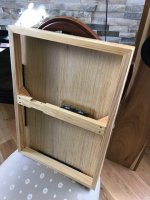
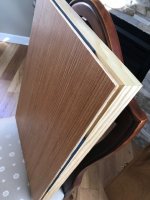
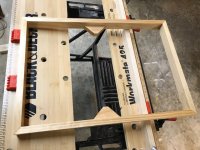
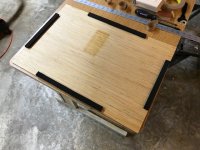
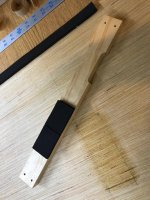
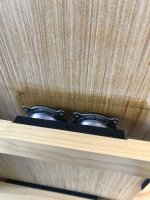
Not sure if this helps, but here are some images of a fairly simple and light frame construction for my 400 mm x 580 mm plywood DML. The framing members are 64 mm x 19 mm pine. Perhaps something similar might work for you. I can weigh it later but I suspect each speaker is under 1.5 kg. The main drawback of this design for you, I suspect, is that the frame does nothing to protect the face of the panel. However, I think there are some easy ways to fix that, which I could suggest if you think it would be useful, although it would all a little more weight.
Eric






Obviously my frames would not handle proper road abuse for long. The wood would scratch and dent if not handled carefully, and I certanily would need a mesh to protect the plates.Hi Leo
I have been following you since your first post with great interest, I must say that your videos are very enlightening and to some extent inspired me, having said that the reason why it all started is because being an insider in the professional sector I wanted to see if there could have been an improvement in the logistics sector hoping to reduce weight and size, this as you know is a fundamental aspect at least for a certain target of users, being able to bring everything in a flight case would be fantastic. Obviously the quality must be at least close to traditional systems , I'm not saying superiors but close, having made this premise in the last two years I evaluated the thing and starting from the tectonic experience I realized that it was the way to go, of course you don't have the same exciters available so they will certainly never be the same , but after having created a prototype I must say that I am pleasantly surprised, in order not to make a mistake as I said I had a frame made with important and heavy woods to prevent vibrations and therefore affect the functioning, now the time has come to try to optimize all and therefore if possible not to lose sight of the main reason for all this THE Weight. So I return to the first question which has the purpose of assembling with a simple light frame with a depth of no less than 50mm to contain the exciter, the 'exciter screw adapter, the rear structure that maintains the exciter weight and obviously the panel all within these 50mm or so. As regards the results I have obtained so far, I can say that they have good power handling , in particular if you cut the parts up to 100hz or a little less, for the quality left in flat it is an excellent sound, slightly lacking in the highs but easily compensated for, for the lows a different matter opens up if we start from the principle that there is always a support with traditional sub loudspeakers etc. the problem does not arise, otherwise for small places indoors they are fine even as a broadband however it is not justified to have 4 exciters if you place them on the ground using the floor level they are fantastic, but we are not doing all this to hear them a few meters away I think we would like to hear them well even at great distances so going back to the subject in any case if we hung the lower part we could not appreciate it so it is better to avoid and therefore filter everything a priori. Last thing about the points in which the plate is blocked to be able to obtain maximum power while avoiding distortion vibrations for now it is blocked on all sides, the tectonic one is blocked in almost all points but not all, if you notice it has 4 blocks on the long side and then some bands that tighten one part but on all 4 sides, so if you go to see it's almost totally blocked, moreover the frame seems massive, huge and heavy, at least this is the impression I have.
In conclusion I like the result but I have to reduce the weight and make it aesthetically professional, the part of the adhesive tape and bolts is finished I just want to find the right material and procedure, the economic part remains important as an argument but it certainly isn't just that
Having said that, they are cheap to make and fix if something breaks and are very light, so they are perfectly fine for me that use them maybe once or twice a year and have plenty of time between events to service them if needed.
I think Tectonic uses molded aluminium, probably not because the plate needs that stiff a frame, but because it is easy to manufacture in series, very strudy and reasonably light weight. Then they have proper steel grilles for protection.
I would love a design that is as sturdy as that, and would think it is worth the extra weight, but it is very hard to DIY.
I think the kind of design I use is very easy to implement and gives a lot of freedom to adjust the look, wight and sturdyness to your liking.
For example, you can use aliuminum profiles instead of the wood ribs and add grilles, then they would be quite sturdy but still easy to build and fix. The 3D printed parts is not a concern IMO and will stand quite a lot of impact and bending force. There are also specialist filaments that can be used to make them extra strong.
Regarding how much suspension they need, that is something you have to adjust carefully depending on the plate material and dimensions and compliance of the suspension material. My initial attempt I did it similar to Tectonic, but with my GPS plates and the foam strips I used they ended up way overdampended. Perhaps nomex-carbon needs more damping, at least if you have very thin carbon skin. But your plates are probably different than the ones they use even if materials are the same, so again you have to do trail and error.
One thing I've noticed is that there don't seem to be substantial differences between my system and a normal traditional speaker in terms of feedback, tectonic shows this in a video but it seems unrealistic to me
In terms of feedback, I think it depends how much reverb there is in the room and how far the microphone is from the panel. The wavefront right in front of the panel (say up to a metre or so?) is uncorrelated. And a microphone stuck right up against the panel picks up only certain antinodes, and does not feed back as easily as with a pistonic cone which presents a fully-developed, fully correlated wave even at close distances.
However, it seems that a DML wavefront does eventually 'solidify' at some distance, and will therefore feed back and will cause just as much echo and reverb as a traditional cone speaker.
So it looks like there's a non-linear relationship between mic distance and feedback sensitivity for DML panels. At very close distances (a few cm) it does not feed back as easily as a cone, but at performance distances it seems the same as any other speaker.
I have also stuck a mic right into a panel to show off resistance to feedback to potential customers, but otherwise the rest of the above is just my own unsubstantiated, untested opinion.
However, it seems that a DML wavefront does eventually 'solidify' at some distance, and will therefore feed back and will cause just as much echo and reverb as a traditional cone speaker.
So it looks like there's a non-linear relationship between mic distance and feedback sensitivity for DML panels. At very close distances (a few cm) it does not feed back as easily as a cone, but at performance distances it seems the same as any other speaker.
I have also stuck a mic right into a panel to show off resistance to feedback to potential customers, but otherwise the rest of the above is just my own unsubstantiated, untested opinion.
Last edited:
Sooo I've been playing with this... after battling with Tectonic exciters, and multiple variations of substrates and laminates, I've eventually settled on 20mm EPS with paper skins which sound kinda ok.
The screen-shot shows FR curves for two panels sized 460 x 770mm and measured nearfield (50cm). The panels are fixed, undamped, on their long sides, and the short sides are unsecured. The drivers (one only per panel) themselves are bolted into a stay, and mounted on 100m dia polycarb discs behind a 105mm hole cut out of the EPS. Three blobs of hot-glue secure the polycarb discs to the EPS. The paper skins are the only damping.
As the other pic shows, I WAS going to do a hybrid open-baffle with a 15" high-Qts driver for the extreme lows, but the slight bass loss vs better dynamics and definition (without the cross-over and additional woofer) is a no-brainer. So these curves are for the panel only.
The difference between the curves is due to the amount of glue used to secure the paper to the EPS. The panel with the flatter response (blue) weighs about 240g in total, and t'uther (red with the peak at 3k) is about 290g. Too much glue...
Next step: Drive this baby with 4 exciters per side and see if I can use it for live gigs. Each panel SHOULD handle around 160WRMS. And at around 99dB/W sensitivity per panel, this translates to over 119dB when driven at 300W peak.
I suspect that the EPS/paper laminate might not handle so much ferocious abuse for 3 or 4 hours at a time. In which case I might have to revert to polycarb twin-wall panels, and a bit of EQ.
Whaddaya tink?
View attachment 1095332
Hi Andre
Do you have four spare Exciters of the same model?
Can you record the SPL curves of the four exciters free in air without any panels?
I'm thinking these things are heavy
I suspect that these high frequencies seem to be purely from the sound of the "coil"???
Thank you very much~
Guys, I've hit a bit of a brick wall regarding high-efficiency panels. Theoretically one should be able to increase loudspeaker sensitivity up to 120db/W (100% efficiency) by simply adding more and more speakers in various series/parallel configurations to retain a minimum 4-ohm load to the amp. Of course this is impractical in real life. Loudspeaker simulation packages all seem to agree that this is possible in theory.
But using DML panels (Twinwall polycarb) and exciters (25FHE-4 or 32QMB-4 or 30HESF-4,) in real life on the workbench I find that four drivers per panel seems to be the limit, and anything more than that actually decreases sensitivity no matter what funny tricks I use to keep the load to around 4-ohms. Obviously I could wire more drivers in parallel to present a 1 or 2-ohm load. But that's cheating and the power amp will probably not like it very much anyway.
Have any of you noticed a similar problem?
But using DML panels (Twinwall polycarb) and exciters (25FHE-4 or 32QMB-4 or 30HESF-4,) in real life on the workbench I find that four drivers per panel seems to be the limit, and anything more than that actually decreases sensitivity no matter what funny tricks I use to keep the load to around 4-ohms. Obviously I could wire more drivers in parallel to present a 1 or 2-ohm load. But that's cheating and the power amp will probably not like it very much anyway.
Have any of you noticed a similar problem?
I didn't try putting more than 4 exciters per plate...it seems like a sweet spot, and figured more would be impractical while keeping plates compact size.
I guess that as you add more exciters you add more mass to the plate, and especially with the exciters more spread out they can potentially work against each other a bit, so it will not be the same as adding multiple individual cones where each added cone behaves the same.
I guess that as you add more exciters you add more mass to the plate, and especially with the exciters more spread out they can potentially work against each other a bit, so it will not be the same as adding multiple individual cones where each added cone behaves the same.
Andre..... for more SPL, what about making a EPS panel with the exciter mounted to the 100mm polycarb disc like you did earlier, but with more than 1 polycarb disc on the panel ?
Or for every exciter on the back of the panel, place another exciter in the same spot on the front of the panel, I think someone in the long DML thread called this push-pull.
Hi Dean,Andre..... for more SPL, what about making a EPS panel with the exciter mounted to the 100mm polycarb disc like you did earlier, but with more than 1 polycarb disc on the panel ?
Yes I did try this. But I didn't get a good-enough frequency response to be useable, but I also did not spend enough time on it to get it right.
It's a good direction to explore.
Hello,Hi Dean,
Yes I did try this. But I didn't get a good-enough frequency response to be useable, but I also did not spend enough time on it to get it right.
It's a good direction to explore.
I haven't tested this push-pull configuration but I removed material in the central area (voice coil inner area) in the standard single exciter configuration which leads to a HF loss. So to check the effect of the mask. Is there an advantage to 2 exciters on the same side?
Christian
Finally back to thinking about speakers again!
I bit the bullet and ordered some subs, amplifiers and DSP processor so I have a complete system that I can tune at my own leisure.
Going for some paraflex subs from HOQS: https://www.hoqs.eu/products/hoqs-eu-df-212-subwoofer
I haven't had a chance to listen to any yet, but heard many positive things about them and response graph looks really amazing considering their size, and they can handle a lot of power. For the music that it will be used for I think response below 40Hz is wasted any way, and these looks like they can beat many 2x18" in the frequencies that really matters...but is half the size and weight!
DSP processor is this one: https://www.alibaba.com/product-detail/Professional-audio-system-4x8-input-output_1600613448329.html
I wanted one with 4 inputs to I can run quadraphonic. Due to how great the spatial image is when using DML, I think that can be worthwhile to try out. And with that I can run 4 channels direct from digitally from my laptop using the AES/EBU channels when performing.
It has quite a lot of DSP power and can do FIR filters with 960 taps. Not sure how much I will use that, but curious to try out using an inverted response to generate a FIR filter to even out the DML panels and see how it compares to a regular EQ profile.
For the DML speakers, I find that they started to sag a little causing distortion. Initially I made the braces a bit tighter, but that resulted in too much tension, lifting up the exciter, resulting in distortion and reduced sensitivity. When gluing the exciters I did not push the plate as much as possible downwards when setting the position, and with time suspension became a bit softer so they could move downwards a mm or so, causing the exciters to be slightly off axis.
Plan now is to tweak the design of the braces a little to get them tighter without pushing the exciter and use a tougher rubber for clamping with adhesive on both sides so that the plate cannot move at all.
I bit the bullet and ordered some subs, amplifiers and DSP processor so I have a complete system that I can tune at my own leisure.
Going for some paraflex subs from HOQS: https://www.hoqs.eu/products/hoqs-eu-df-212-subwoofer
I haven't had a chance to listen to any yet, but heard many positive things about them and response graph looks really amazing considering their size, and they can handle a lot of power. For the music that it will be used for I think response below 40Hz is wasted any way, and these looks like they can beat many 2x18" in the frequencies that really matters...but is half the size and weight!
DSP processor is this one: https://www.alibaba.com/product-detail/Professional-audio-system-4x8-input-output_1600613448329.html
I wanted one with 4 inputs to I can run quadraphonic. Due to how great the spatial image is when using DML, I think that can be worthwhile to try out. And with that I can run 4 channels direct from digitally from my laptop using the AES/EBU channels when performing.
It has quite a lot of DSP power and can do FIR filters with 960 taps. Not sure how much I will use that, but curious to try out using an inverted response to generate a FIR filter to even out the DML panels and see how it compares to a regular EQ profile.
For the DML speakers, I find that they started to sag a little causing distortion. Initially I made the braces a bit tighter, but that resulted in too much tension, lifting up the exciter, resulting in distortion and reduced sensitivity. When gluing the exciters I did not push the plate as much as possible downwards when setting the position, and with time suspension became a bit softer so they could move downwards a mm or so, causing the exciters to be slightly off axis.
Plan now is to tweak the design of the braces a little to get them tighter without pushing the exciter and use a tougher rubber for clamping with adhesive on both sides so that the plate cannot move at all.
- Home
- Live Sound
- PA Systems
- DML PA systems